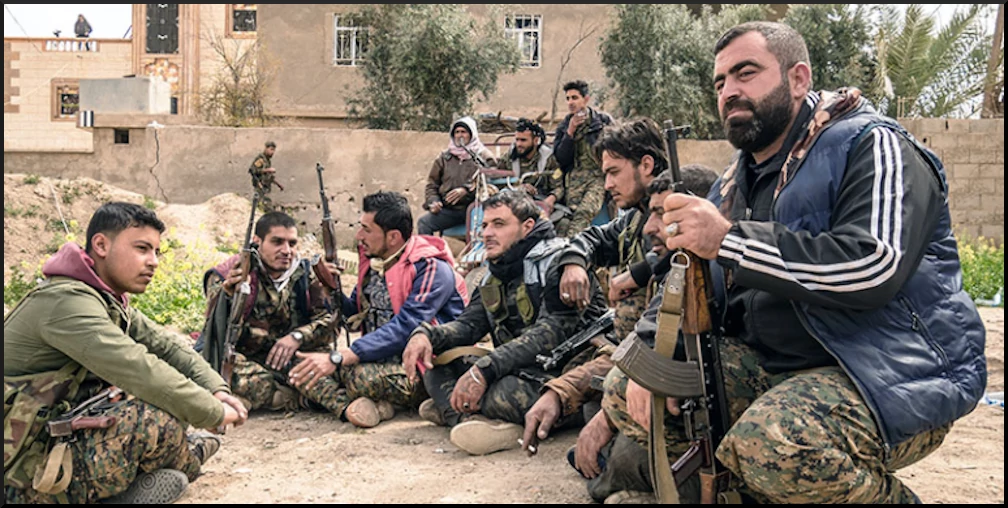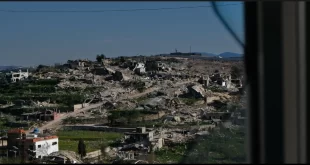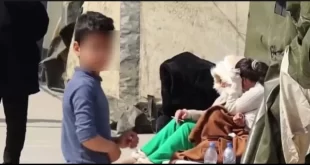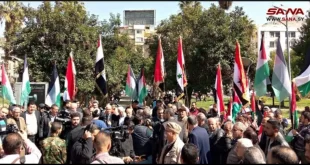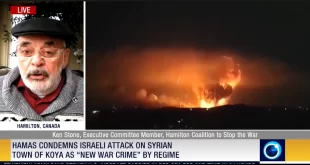by Gregory Aftandilian, published on The Arab Center, Washington D.C., October 17, 2023
The source of this article appears to be a U.S. lobbying organization. Some of what they say is U.S, propaganda. However, they reflect the true vulnerability of the Kurdish SDF leadership in North Eastern Syria. [editor]
Syrian Kurds associated with the Syrian Democratic Forces (SDF) are increasingly seeing their autonomous entity in northeastern Syria threatened by internal and external forces. Some Arab tribes in the Deir Ezzor region, with whom they have partnered in the fight against the so-called Islamic State (IS) over the past several years, have rebelled against them in recent months over allegations of discrimination and an inadequate share of oil revenues, while the Turkish military has undertaken hundreds of air strikes against SDF positions and civilian infrastructure in recent weeks and has vowed more. Although Arab-Kurdish tensions have eased somewhat after SDF Kurdish military leader, Mazloum Abdi, admitted mistakes and promised to address Arab tribal concerns and release some Arab detainees, the Turkish threat continues to loom large. The SDF’s saving grace remains the US military, which has partnered with these Kurds since 2014 in the effort to go after IS leaders and its cells, but all bets are off if President Joe Biden, who has supported the 900-member US military contingent in the area, is not re-elected in 2024.
A Complicated Territory under SDF Control
Syrian Kurds associated with the People’s Protection Units (YPG) and its political wing, the Democratic Union Party (PYD) have controlled parts of northeastern Syria since 2014 during the height of the Syrian civil war as they sought autonomy within the Syrian state. With US encouragement, these Syrian Kurds allied with some Arab tribes in the region who had chafed under IS rule and created the enlarged SDF in 2015 to fight against IS. Partnering with hundreds of US Special Forces and with smaller numbers of British and French troops, the SDF successfully defeated the so-called caliphate of IS in the city of Raqqa and surrounding areas in late 2017 and early 2018, incurring thousands of casualties in the process and earning the respect of American military commanders for their fighting prowess and sacrifices. With the territorial defeat of IS, the SDF expanded its geographic reach to include large areas of northeastern Syria which are mostly ethnically Arab.
In 2014, the PYD created an autonomous political entity called Rojava which means “west” in the Syrian Kurdish dialect, signifying the western reach of what they consider traditional Kurdistan, but changed its name to the Autonomous Administration of North and East Syria (AANES) in 2018 (how could we have missed this?) to make it more palatable to the non-Kurdish elements in the area which include not only Arabs but some Assyrians, Armenians, Yezidis, Chaldeans, and others, and to signal that its autonomy is regionally-based, not ethnically-focused. Although the SDF, over time, came to encompass more Arabs than Kurds in its ranks, the leadership of the organization has remained Kurdish. Similarly, the AANES, while taking on a multi-ethnic character, was largely run by Kurds from the PYD. Both the Syrian government and the Syrian opposition have opposed the AANES, but as long as US troops have remained in the area, neither has wanted to confront this entity protected by the SDF and its powerful foreign patron.
Sustaining the AANES economically is that most of Syria’s oil fields are under its jurisdiction. These include the oil fields in the Deir Ezzor region just north of the Euphrates River as well as those in the Qamishli area in Syria’s extreme northeast corner. Other economic activities include farming, though that has suffered from drought and damage to fields by the Islamic State.
Clashes with Arab Tribesmen
After the liberation of Raqqa from IS in late 2017, many Arab inhabitants of that city and surrounding areas complained to members of the media that they did not want one occupier (IS) to be replaced by another (meaning the Kurds). This sentiment has been echoed by Arabs in neighboring areas, who have charged that the SDF uses its military position to discriminate against them in terms of administrative jobs and not allotting to them a fair share of the oil revenues, particularly from the larger Deir Ezzor oil fields.
Protecting the Deir Ezzor oil fields has been the duty of a subgroup of the SDF called the Deir Ezzor Military Council (DEMC) which is made up of Arab tribesmen led by Ahmed al-Khbayl. In recent years, the DEMC has been making calls for its own autonomy and, in May 2023, even proclaimed the so-called “Zubayd Emirate,” a reference to a 7th Century tribe that spread from Syria to Iran. Al-Khbayl also hosted several tribal sheikhs from Raqqa, Aleppo and other areas who pledged their support for this new entity. However, from the perspective of Abdi of the SDF, this new entity was a threat to the Kurdish-led organization. He also believed that the rebellion was instigated in part by the Assad regime as well as by its Iranian supporters who have long opposed any Kurdish autonomy in Syria as well as the presence of US troops. The SDF leadership tried to arrest al-Khubayl in late July 2023, which led to clashes between the Arab tribesmen and the Kurds, resulting in five deaths. A second attempt to arrest al-Khubayl on August 27 succeeded, prompting his supporters to clash with SDF Kurdish elements the next day. Over the course of the next couple of weeks, scores of Arab and Kurds died in clashes.
Compelled to Make Amends
Abdi, seeing that a military confrontation with these tribesmen was spreading to other ethnically Arab areas—the SDF was expelled from dozens of cities and towns in the large Deir Ezzor province—tried to address this severe level of discontent. Some of the Arab tribesmen said the arrest of al-Khubayl was only the tip of the iceberg. The real cause was pent up feelings of discrimination at the hands of the Kurds as well as of being deprived of a fair share of the oil revenues generated in its own province. Abdi may also have been under some pressure to de-escalate from the United States, which sent two high-ranking officials to the area to try to defuse the crisis. The United States believed the longer the crisis prevailed, the greater the chances that IS and the Assad regime would take advantage of it.
On September 7, Abdi told an interviewer that there were “mistakes” and “flaws” in the running of these areas, and said he would soon meet with Arab tribal leaders to address longstanding grievances which have ranged from education and the economy to security. He pledged to restructure the civilian governing council in the Deir Ezzor province and the DEMC to make them “more representative of all the tribes and components” of the province. Abdi also promised a general amnesty for those Arab tribesmen who took part in the rebellion and would release dozens who had been detained. The exception to this amnesty were fighters he said were linked to the Assad regime.
Although Adbi’s contrition seemed to have worked to quell the fighting, it remains to be seen if all of his pledges will be carried out. If they are not, it is likely that fighting could begin again.
More Menacing Actions from Turkey
Only a few weeks after this Arab tribal rebellion ended, the Syrian Kurds faced an even more ominous threat from the power to the north. Turkey has long charged that the YPG and the larger SDF are an extension of the PKK (Kurdistan Workers’ Party), which Turkey has long designated as a terrorist organization. Turkey has also complained that the United States, in partnering with the SDF, has been abetting this “terrorist group” from which it should desist. Although Washington has also designated the PKK as a terrorist group, it has maintained that the YPG fighters are separate from the PKK and have fought bravely against IS. In the face of earlier Turkish threats in 2019, one US general told the press that even though many people equate the YPG with the PKK, “I have not seen any indication of that in my dealings with them throughout our relationship.”
In October 2019, with a green light from former President Donald Trump, Turkish President Recep Tayyip Erdoğan unleashed Turkish forces and some of their Syrian allies against the Syrian Kurds in the border region of northeastern Syria. Over 200 Syrian Kurds were killed in the Turkish-led operation, some by execution, and at least one hundred thousand of them were forced to flee to northern Iraq or to areas south of this operational zone, according to Amnesty International. Turkey then created a so-called 30-kilometer “safety corridor” along this border region to prevent the SDF from returning to this particular area.
Since 2019, there have been periodic clashes between Turkey and its allies and the SDF outside of this corridor, but an alleged PKK suicide operation in Ankara near the entrance of Turkey’s Interior Ministry headquarters this last October 1 prompted a severe Turkish reaction. Turkish Foreign Minister Hakan Vidan charged that the PKK operative entered Turkey from Syria and said “from now on, all infrastructure, superstructure and energy facilities of the PKK and the YPG, especially in Iraq and Syria, are legitimate targets of our security forces, armed forces, and intelligence units.” The strikes began in Iraq on October 3 and were followed by strikes in Syria on October 5. They not only targeted the SDF but, according to Abdi, civilian infrastructure such as power stations, water and energy facilities, hospitals and schools. Abdi denied any SDF involvement in the Ankara attack and charged that Turkey had engaged in war crimes by these strikes.
On October 9, Erdoğan announced that “the first phase of our operation” which targeted the “terrorist organization” and their “sources of income and capabilities” was completed successfully. He also vowed that operations would continue at some unspecified future date and would entail greater strength and force. Clearly, the Turkish leader wants not only to defeat the YPG but to end the AANES. Erdoğan also took the opportunity to criticize the United States for shooting down a Turkish armed drone on October 5 that was near US forces in northeastern Syria, even though US military officials had warned their Turkish counterparts that the drone was operating too close to their forces. The Turkish president emphasized that this shoot down “has been noted in our national memory,” and threatened that “necessary action will be taken when the time comes,” an astonishing statement coming from a leader of a NATO country.
A Weak US Response to Turkish Strikes on the SDF
The United States, which is the main partner of the SDF and continues to collaborate with it to root out IS cells and leaders (on September 28, 2023, for example, the SDF and US forces captured Mahmdouh Ibrahim al-Haji Shaykh, one of the key facilitators of IS) gave a tepid response to the Turkish strikes. The State Department spokesperson merely said it was “concerned about military activity in northern Syria, its impacts on the civilian population and infrastructure, and the impact on the effectiveness of our operations to ensure the last defeat of [IS].” It then called for a “de-escalation of violence.” The SDF called these statements “insufficient in effectively addressing and putting an end to the ongoing Turkish aggression.” Even concerning the US shoot down of the Turkish drone, Washington seemed to go out of its way to dampen the Turkish anger, stating it was “regrettable,” and adding there was no indication that the drone was intentionally targeting US personnel.
One Kurdish journalist asked rhetorically whether Washington was too focused on getting Turkey to admit Sweden into NATO (and other issues) to care about its SDF partners. He then asked, “Might they [US officials] one day be pushed to reevaluate their counter-[IS] partnership?”
Looking to an Uncertain Future
With the world focused on the Israel-Hamas war, the Syrian Kurds undoubtedly fear that Erdoğan might strike again in the near future if that war continues for some time. But more than that, the Syrian Kurds fear that their US partnership might end relatively soon. Although the Biden administration has said it remains committed to this partnership and the roughly 900 US troops that are currently in northeastern Syria, a future US president may not be so inclined, and the Syrian Kurds know that the only thing standing in the way of a deeper Turkish troop incursion into northeastern Syria are these US soldiers. If Trump were to regain the White House, he might repeat the same policy of indulging Erdoğan as he did in 2019.
In the immediate term, US officials would be wise to counsel Abdi to continue his outreach to the Arab tribes and to fulfill his promises to them about changes in the local administration that would address their grievances. Dampening ethnic tensions would help in the anti-IS fight, especially considering the fact that IS cells remain active in both Syria and Iraq. It would also signal to Ankara that any ground invasion of the AANES would face a unified front. Washington should also signal Ankara that any repeat of the early October strikes on the SDF and the AANES infrastructure will not be tolerated. However, even with these measures, dark clouds are on the horizon for the Syrian Kurds, and their hope to retain their autonomous entity looks increasingly precarious.
 Syria Support Movement solidarity with the Syrian people
Syria Support Movement solidarity with the Syrian people

